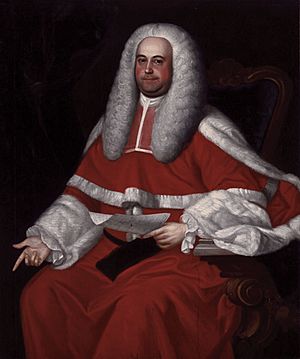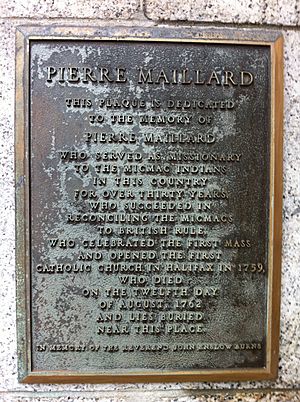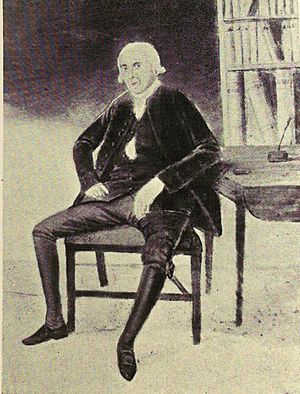Burying the Hatchet ceremony (Nova Scotia) facts for kids
The Burying the Hatchet Ceremony was a very important event that happened in Nova Scotia on June 25, 1761. It was one of several ceremonies where the Halifax Treaties were signed. These treaties helped to end a long period of fighting that had lasted over 75 years. This conflict involved six wars between the Mi'kmaq people and the British.
The Burying the Hatchet Ceremonies and the treaties they celebrated created a lasting peace. They also showed a promise to follow the rules and laws. While some British promises were not fully kept, the treaties were later added to the Canadian Constitution in 1982. Since then, courts, including the Canadian Supreme Court, have supported these treaties. A well-known case that upheld them was the Donald Marshall case. Today, people in Nova Scotia celebrate these treaties every year on Treaty Day (October 1).
Why the Ceremony Happened


For many years, the area of North America that included New England and Acadia (which is now parts of Canada and the U.S.) was a place of conflict. The French and British Empires were often at war. The Wabanaki Confederacy, which included the Mi'kmaq, also had conflicts with British settlers.
During a time called Father Le Loutre's War, Edward Cornwallis tried to protect British settlers in Nova Scotia. The fighting continued into the French and Indian War. During this war, French officers, Mi'kmaq, and Acadians fought against the New Englanders. This happened especially after the Acadians were moved from their homes.
The British eventually won major battles, like capturing Louisbourg in 1758 and fighting at Quebec in 1759 and Montreal in 1760. This meant the French power in North America was greatly weakened. With their French allies no longer able to help, the Mi'kmaq realized they needed to form a new relationship with the British.
Before the main Burying the Hatchet Ceremony, other treaties were signed with different Mi'kmaq and Maliseet tribes. For example, in February 1760, two tribes from the Passamaquoddy and Saint John River areas came to Halifax to renew an earlier treaty.
A French priest named Pierre Maillard played an important role. He was invited by Nova Scotia Governor Charles Lawrence to help talk with the Mi'kmaq people. Maillard was able to convince most of the Mi'kmaq chiefs to sign peace treaties with the British in Halifax.
The Ceremony Itself
The "Burying of the Hatchet Ceremony" took place on June 25, 1761. It was held in Governor Jonathan Belcher's garden. This garden was located on what is now Spring Garden Road, Halifax, near the Court House.
Many important people were there. Representing the British colony were Governor Belcher and four members of the Nova Scotia Council. Also present were high-ranking military officials, including Admiral Lord Colville and Major-General John Henry Bastide. They were joined by a group of soldiers.
At least four Mi'kmaq chiefs signed the treaty: Jeannot Peguidalonet from Cape Breton, Claude Atouach from Shediac, Joseph Sabecholouet from Miramichi, and Aikon Ashabuc from Pokemouche. Other representatives from different Mi'kmaq villages were also there.
The event was very grand and formal. The two groups faced each other near a British flag. French priest Pierre Maillard stood in the middle, helping to translate. Governor Belcher promised that the British would protect the Mi'kmaq from unfair traders. He also promised to protect their religion and not interfere with Catholic missionaries.
Belcher gave gifts to each chief, along with special medals. These medals were passed down through generations as a reminder of the peace agreement. Then, Belcher and the chiefs moved to the flag post. There, they formally "buried the hatchet." This was a symbolic act to show that the fighting was over.
One of the Mi'kmaq Chiefs said that he was burying the hatchet for his whole tribe. He said it was a sign of their peace. The Chief from Cape Breton Mi'kmaq declared that the peace would last "As long as the Sun and the Moon shall endure."
During the ceremony, the chiefs also washed paint from their bodies. This was another symbol that the fighting had ended. The ceremony finished with everyone drinking to the king's health. Today, the cornerstone of the Halifax Provincial Court stands near where the hatchet was buried. It is a symbol of peace and the importance of law.
What Happened Next
The Halifax Treaties successfully brought peace between the Mi'kmaq and the British. Both sides promised to follow the law.
These treaties are still very important today. Nova Scotians celebrate them every year on Treaty Day. The treaties show a lasting commitment to peace and understanding between different peoples.


